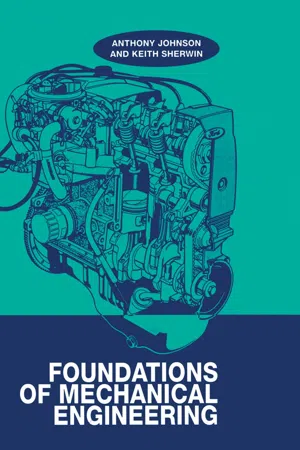1.2 Mechanical Engineering
In order to study the foundations of mechanical engineering, it is first necessary to understand what is meant by the expression ‘mechanical engineering’.
As a starting point, mechanical engineering can be defined as that branch of engineering concerned with the design, manufacture, installation and operation of engines and machines. One of the key functions of mechanical engineering is to design new products. To do so, the engineer must be able to analyse the product in order to assess its performance and to ensure that it is strong enough to perform its duty. As such, the analysis of mechanical engineering systems and components involves an understanding of the principles of the following topics in mechanical science:
dynamics
statics
solid mechanics
material science
thermofluid mechanics.
These topics are introduced and discussed in the following chapters.
The term ‘mechanical engineering’ originated in the nineteenth century. Before that, there were two recognized branches of engineering, namely military engineering and non-military, i.e. civil, engineering. These were concerned with the building of roads, bridges and canals. The civil engineering activities were recognized by the formation in the UK of the Institution of Civil Engineers, the first professional engineering society, in 1818, with Thomas Telford as its first president.
With the spread of railways in the 1830s and 1840s, it was recognized that two different branches of engineering were involved. The building of bridges, viaducts and tunnels obviously involved civil engineering but the design and maintenance of steam locomotives involved a different set of skills. As a consequence, the Institution of Mechanical Engineers was established in Birmingham in 1847, with George Stephenson as its first president. The headquarters of the Institution were transferred from Birmingham to London in 1877.
Steam engines played a major role in the development of mechanical engineering throughout the nineteenth century, with application not only for transportation but also in industry. Even now, steam turbines are used for the generation of electricity in fossil fuelled and nuclear power stations.
During the twentieth century mechanical engineering has become much broader, embracing internal combustion engines, drive mechanisms, machine tools, air-conditioning plant and refrigeration systems. Modern society would be impossible without the products of mechanical engineering. In the home, a flick of a switch brings into operation devices that depend on electricity generated by means of a mechanical system in a thermal power station. Even the use of renewable energy sources using hydroelectric systems and wind turbines depends on mechanical engineering devices. Outside the home, all forms of transportation rely on engines, structures and drive systems created by mechanical engineers.
The above description gives a brief outline of mechanical engineering in order to set the scene for the topics discussed in the following chapters. If it gives the impression that mechanical engineering is a broad-based activity without which modern society could not functions, then it has achieved its purpose. Additional information on the history and development of mechanical engineering can be gained from Derry and Williams (1970) and Rolt (1960, 1967).
1.3 Problem Solving
The whole purpose of studying mechanical engineering is to be able to solve problems. To do this, the student must have a good understanding of the physical behaviour of the device or situation under consideration. In order to be able to analyse such devices it is first necessary to be able to model the situation.
A model is a means of representing the real device or situation. The most familiar type of engineering model is probably the ‘scale’ model. For example, an aircraft manufacturer would not go to the expense of building a full-sized prototype without first carrying out tests on scale models in the wind tunnel to evaluate the performance characteristics.
Although scale models are used in mechanical engineering, their use is not as widespread as might be imagined. When designing a new internal combustion engine, for example, little of value can be gained from a test on a small-scale model of the engine. This is due to what is called the ‘scale effect’. The friction and heat losses for a model are proportionally greater than for a full-sized engine. This is because the surface area of a component, as a ratio of its contained volume, increases as the component becomes smaller, resulting in proportionally greater losses. From the alternative point of view, losses are reduced as the size is increased. This is why some of the larger animals, such as elephants, have low thermal losses and tend to ‘overheat’.
Scale models do not form part of the topics within this text; nevertheless, modelling is an essential part of problem solving and forms the basis for the subseque...
